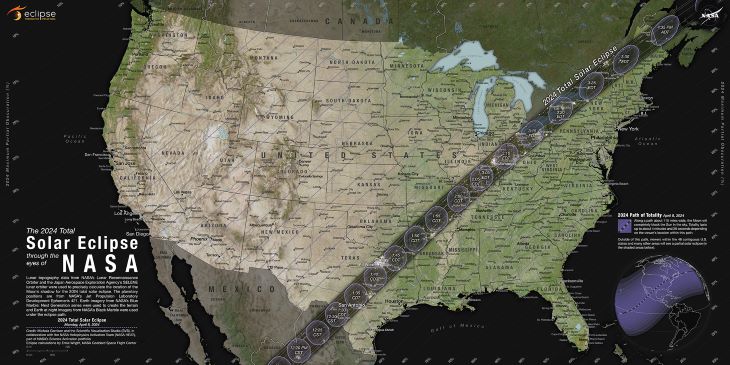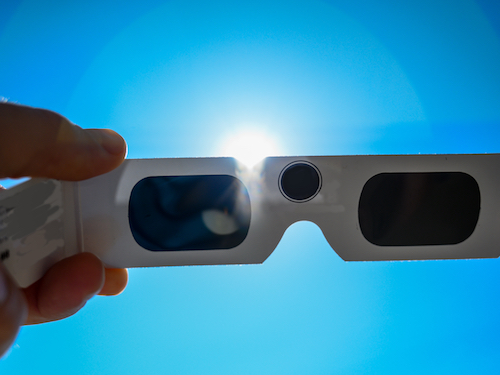How to protect your eyes during the 2024 solar eclipse
An ophthalmologist explains why staring at the sun can cause severe vision loss and how you can watch the eclipse safely
On April 8, millions of people across the United States will be tempted to stare at the sun as large areas of the country experience a total or partial solar eclipse. A solar eclipse is when the moon blocks, or partially blocks, the sun, casting a shadow on the earth.
But staring at the sun without eye protection — even if it’s partially blocked by the moon — can lead to vision loss.
The bad news is that there is no treatment for sun damage in the eye once it has occurred, according to Kareem Moussa, an ophthalmologist at the Ernest E. Tschannen Eye Institute at UC Davis Health.
“The damage can start to occur in less than a minute of staring at the sun, and it may not be noticeable until hours later,” Moussa said.
Moussa is an expert on the human retina. He explained that the eye focuses light onto the retina, the area at the back of the eye. The retina transmits signals from the eye to the brain through the optic nerve, allowing us to perceive images of the world.
“A functioning retina is required for good vision. Staring at the sun causes toxicity, or damage, to some of the cells in the retina. When these cells are damaged, the normal flow of information from the retina to the brain is interrupted,” Moussa explained.
Staring at the sun any time — not just during an eclipse — can lead to eye damage. Moussa has treated patients with sun-damaged retinas.
“Typically, the damage will become noticeable over the following 12 hours after staring at the sun and persists for three to four months. Usually, this leads to a blind spot in the middle of one’s vision or an area of distorted vision. The impact on vision can be severe,” Moussa said.
People can also experience objects looking crooked when they should be straight or things looking bigger or smaller than they should be. If someone is having any of these symptoms, they should seek an evaluation from an ophthalmologist.
Moussa notes that although anyone can develop severe damage from looking at the sun, kids are even more vulnerable. That’s because they have very clear lenses in their eyes, compared to adults, which let in more light. “As we get older, the lens inside the eye gradually becomes cloudier,” Moussa explained. “Younger people also tend to have more dilated pupils, which lets more light into the eye, and can lead to more damage from staring at the sun.”
For people who experience sun damage to their eyes, there is usually some recovery over the following six months. But for some, the damage may be permanent, and vision does not return to normal.
This is why preventing the damage in the first place is so important.

No sunglasses, and beware of fake eclipse glasses
The first thing to know is sunglasses will NOT protect your eyes from looking at the eclipse.
“Some people mistakenly think putting on very dark sunglasses will be sufficient. It will not!” Moussa said.
Protective glasses for viewing an eclipse are thousands of times darker than sunglasses.
“Unless the glasses have a solar filter that meets the ISO 12312-2 standard, which is the international safety standard for protecting your eyes from the sun, you will be at risk of developing significant eye damage if you look at the eclipse in sunglasses,” said Moussa.
Unfortunately, counterfeit and fake eclipse glasses that look exactly like authentic ones are hitting the market. Using counterfeit glasses could lead to eye damage.
The American Astronomical Society (AAS) cautions consumers against searching for eclipse glasses on Amazon, eBay, Temu or any other online marketplace and buying from whichever vendor offers the lowest price.
AAS has posted a list of North American manufacturers that meet the ISO 12312-2 international standards, for solar eclipse glasses and handheld solar viewers and a guide to watching the eclipse safely.
NASA also has a useful guide on different ways to safely view the eclipse.
With the right eye protection, viewing the eclipse or partial eclipse can be a great experience. The upcoming eclipse in the U.S. will be a once-in-a-generation event: a full solar eclipse won’t happen in the U.S. again until August 2044.
“The solar eclipse is an exciting event,” Moussa said. “Enjoy it safely.”
Tips in brief
- Ordinary sunglasses, even very dark sunglasses, are NOT safe for looking at the sun
- Make sure eclipse glasses are from a vendor verified as selling glasses that meet ISO 12312-2 standards
- Eye damage from looking at the sun can happen in less than a minute
- Kids’ eyes can be even more vulnerable to sun damage
- Beware of fake and counterfeit eclipse glasses
Resources




